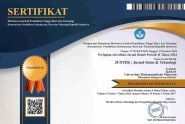Analisis Pengaruh Penambahan Daun Pegagan (Centella asiatica) terhadap Aktivitas Antioksidan Rimpang Jahe (Zingibere officinale )
Abstract
Abstract: Zingibere officinale is one of the most widely used herbs as traditional medicine. However, Z. officinale has a distinctive odor and spicy taste that are dislike by some people. Therefore, additional herbs are needed to overcome this problem without affecting its bioactive properties. In this study, Centella asiatica leaves was used as the additional herbs, in accordance with the Indonesian Herbal Medicine Formulary. The aim of this study is to study the synergistic effect between Z. officinalle and C. asiatica by analyzing their antioxidant activity and the chemical compound. The antioxidant assay was conducted with DPPH method. The IC50 value of Z. officinale was 1.28, while the IC50 of C. asiatica was 3.68, and the IC50 of the mixture 1:1 was 2.51. On the other hand, the chemical compound of each samples were analyzed using Gas Chromatography Mass Spectroscopy (GC-MS). Based on the GC-MS chromatogram, Z. officinale has distinctive compounds that affect its taste, aroma, and antioxidant activity such as 1,8-cineol, Zingiberene, and farnesene. On the other hand, C. asiatica also has compounds that regulate aroma and taste, namely Oxacycloheptadec-8-en-2-on or Ambrettolid which is predicted to hindered the spicy taste in Z. officinale. To get a more accurate conclusion, further studies are needed on the synergistic effect of the two extracts in terms of formulation to the synergism of their compounds.
Abstrak: Zingibere officinale (Jahe) merupakan salah satu tanaman herbal yang paling banyak digunakan sebagai obat tradisional. Namun, jahe memiliki bau khas dan rasa pedas yang tidak disukai oleh sebagian orang. Oleh karena itu, diperlukan tambahan herbal lain untuk menetralisir aroma dan rasa pedas jahe tersebut tanpa mempengaruhi sifat bioaktifnya. Dalam penelitian ini, daun pegagan digunakan sebagai herbal tambahan, sesuai dengan Formularium Jamu Indonesia. Penelitian ini bertujuan untuk mempelajari efek sinergis jahe dan pegagan yang dilihat dari aktivitas antioksidannya dan keselarasan kandungan senyawa kimia di dalamnya. Aktivitas antioksidan dilakukan dengan metode DPPH. Dari analisis antioksidan didapatkan nilai IC50 jahe adalah 1,28, sedangkan IC50 pegagan adalah 3,68, dan IC50 campuran 1:1 adalah 2,51. Untuk melihat potensi lainnya, maka ekstrak jahe dan pegagan dianalisis dengan menggunakan instrument Gas Kromatografi Spektoskopi Massa (GC-MS). Berdasarkan kromatogram GC-MS, jahe memiliki senyawa khas yang mempengaruhi rasa, aroma, dan aktivitas antioksidannya seperti 1,8-cineol, Zingiberene, dan farnesene. Di sisi lain, pegagan juga memiliki senyawa yang mengatur aroma dan rasa, yaitu Oxacycloheptadec-8-en-2-on atau Ambrettolid yang diduga dapat menghambat rasa pedas pada jahe. Untuk mendapatkan kesimpulan yang lebih akurat, diperlukan penelitian lebih lanjut mengenai efek sinergis kedua ekstrak dari segi formulasi terhadap sinergisme senyawanya.
Keywords
Full Text:
PDFReferences
Ahmad, B., Rehman, M. U., Amin, I., Arif, A., Rasool, S., Bhat, S. A., . . . Bilal, S. (2015). A review on pharmacological properties of zingerone (4-(4-Hydroxy-3-methoxyphenyl)-2-butanone). The Scientific World Journal, 2015.
Armansyah, A., Ratulangi, F. S., & Rembet, G. D. G. (2017). Pengaruh penggunaan bubuk jahe merah (Zingiber officinale var. rubrum) terhadap sifat organoleptik bakso daging kambing. Zootec, 38(1), 93-101.
Azzahra, F. (2021). Formulasi, Evaluasi Sifat Fisik dan Uji Iritasi Krim Ekstrak Etanol Daun Pegagan (Centella asiatica).
Breitinger, H.-G. (2012). Drug synergy–mechanisms and methods of analysis. Toxicity and Drug Testing, 143-166.
Hadi, S., Ratnasari, B. D., SepTiyana, M., Priyambodo, S., & Sudarma, I. M. (2019). Antibacterial Assay and Alkaloid Lombine Distribution Study of Voacanga foetida (BI) Rolfe from Lombok Island. Oriental Journal of Chemistry, 35(1), 275.
Harborne, A. J. (1998). Phytochemical methods a guide to modern techniques of plant analysis. springer science & business media.
Heliawati, L. (2018). Kimia organik bahan alam. Bogor: Universitas Pakuan.
Hosni, H. (2006). Anti-viral Activities of Centella Asiatica L. Curcuma Longa L. and Strobilanthes Crispus L. Against Pseudorabies Virus in Animal Cell Lines.
Indrayanto, G., Putra, G. S., & Suhud, F. (2021). Validation of in-vitro bioassay methods: Application in herbal drug research. Profiles of Drug Substances, Excipients and Related Methodology, 46, 273-307.
Kemenkes. (2016). Peraturan Menteri Kesehatan Nomor 9 Tahun 2016 Tentang Upaya Pengembangan Kesehatan Tradisional Melalui Asuhan Mandiri Pemanfaatan Tanaman Obat Keluarga dan Keterampilan. (450).
Surat Edaran Nomor:HK.02.02/IV/2243/2020 Tentang Pemanfaataan Obat Tradisional untuk Pemeliharaan Kesehatan, Pencegahan Penyakit,dan Perawatan Kesehatan., (2020).
Mardawati, E., Achyar, C. S., & Marta, H. (2008). Kajian Aktivitas Antioksidan Ekstrak Kulit Manggis dalam Rangka Pemanfaatan Limbah Kulit Manggis di Kecamatan Puspahiang Kabupaten Tasikmalaya. Universitas Padjajaran.
Nautiyal, O. H., & Tiwari, K. K. (2011). Extraction of ambrette seed oil and isolation of ambrettolide with its characterization by 1H NMR. J. Nat. Prod, 4, 75-80.
Pang, X., Cao, J., Wang, D., Qiu, J., & Kong, F. (2017). Identification of ginger (Zingiber officinale Roscoe) volatiles and localization of aroma-active constituents by GC–olfactometry. Journal of Agricultural and Food Chemistry, 65(20), 4140-4145.
Rachmawati, F., & Nuria, M. C. (2011). Uji Aktivitas Antibakteri Fraksi Kloroform Ekstrak Etanol Pegagan (Centella Asiatica (L) Urb) Serta Identifikasi Senyawa Aktifnya. Jurnal Ilmu Farmasi dan Farmasi Klinik, 7-13.
Raman, B. V., Samuel, L. A., Saradhi, M. P., Rao, B. N., Krishna, N. V., Sudhakar, M., & Radhakrishnan, T. M. (2012). Antibacterial, antioxidant activity and GC-MS analysis of Eupatorium odoratum. Asian J Pharm Clin Res, 5(2), 99-106.
Setyaningrum, H. D., & Saparinto, C. (2014). Panduan Lengkap Gaharu. Penebar Swadaya Grup.
Sutardi, S. (2016). Kandungan Bahan Aktif Tanaman Pegagan dan Khasiatnya untuk Meningkatkan Sistem Imun Tubuh. Jurnal Penelitian dan Pengembangan Pertanian, 35(3), 121-130.
Worldmeter. (2021). Corona Virus:Reported Cases and Deaths by Country or Territory
Yousaf, S., Hanif, M. A., Rehman, R., Azeem, M. W., & Racoti, A. (2020). Indian Pennywort. In Medicinal Plants of South Asia (pp. 423-437). Elsevier.
Zhou, X., Seto, S. W., Chang, D., Kiat, H., Razmovski-Naumovski, V., Chan, K., & Bensoussan, A. (2016). Synergistic effects of Chinese herbal medicine: a comprehensive review of methodology and current research. Frontiers in Pharmacology, 7, 201.
DOI: https://doi.org/10.31764/justek.v5i2.11821
Refbacks
- There are currently no refbacks.
JUSTEK : Jurnal Sains dan Teknologi sudah terindeks
EDITORIAL OFFICE:












.JPG)

